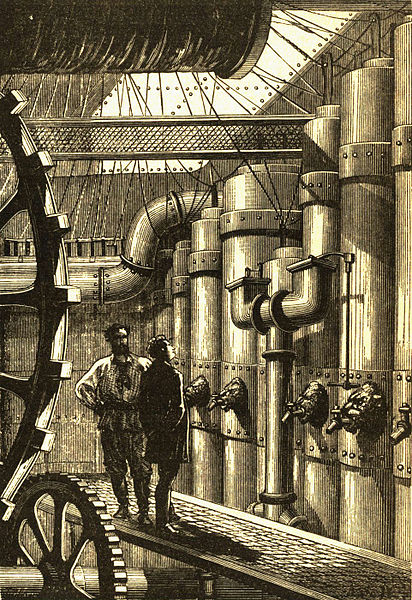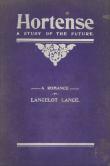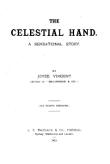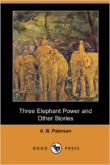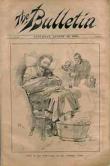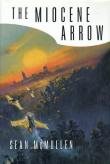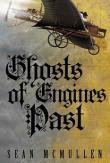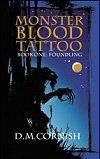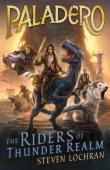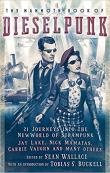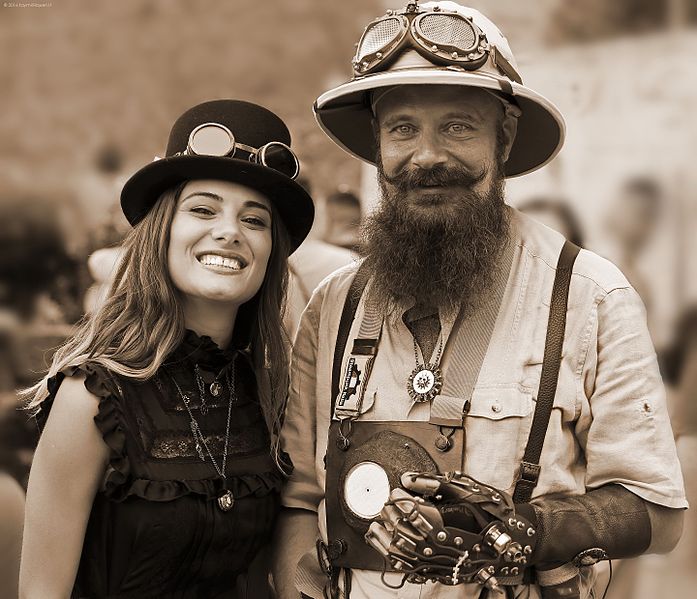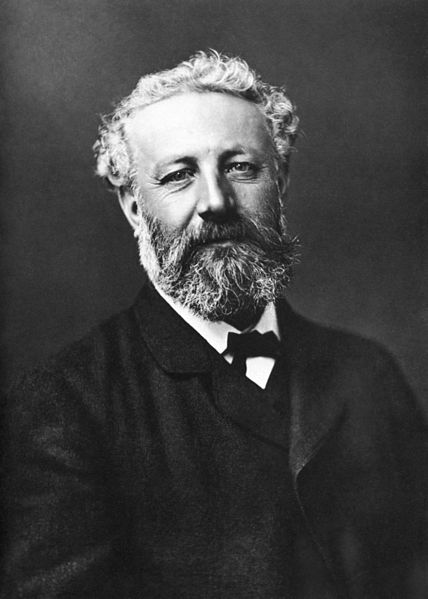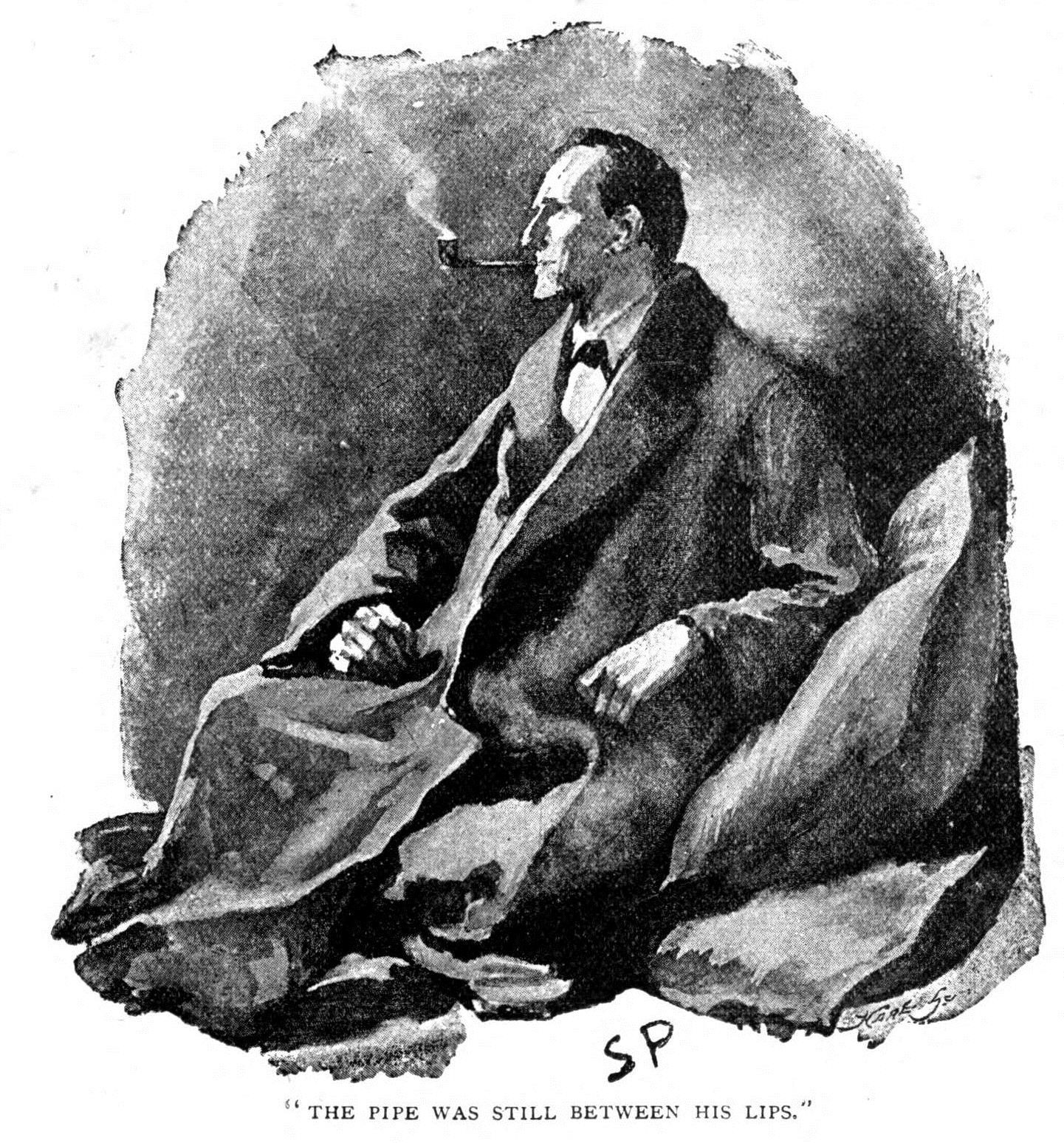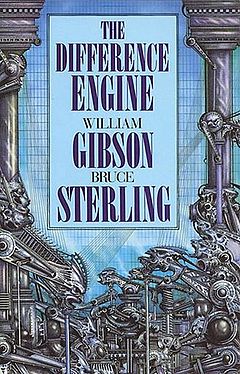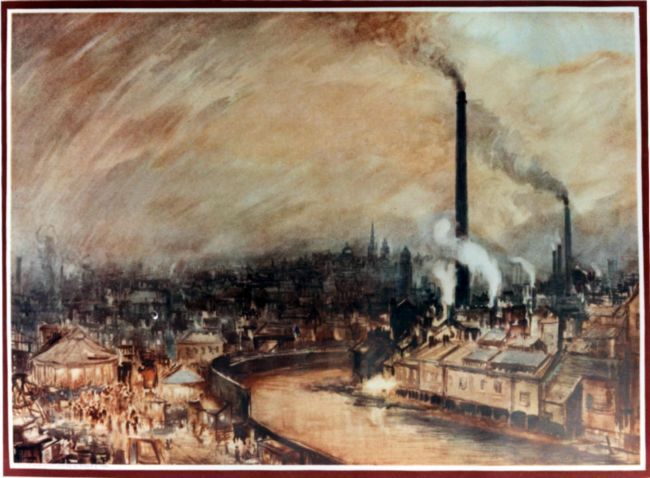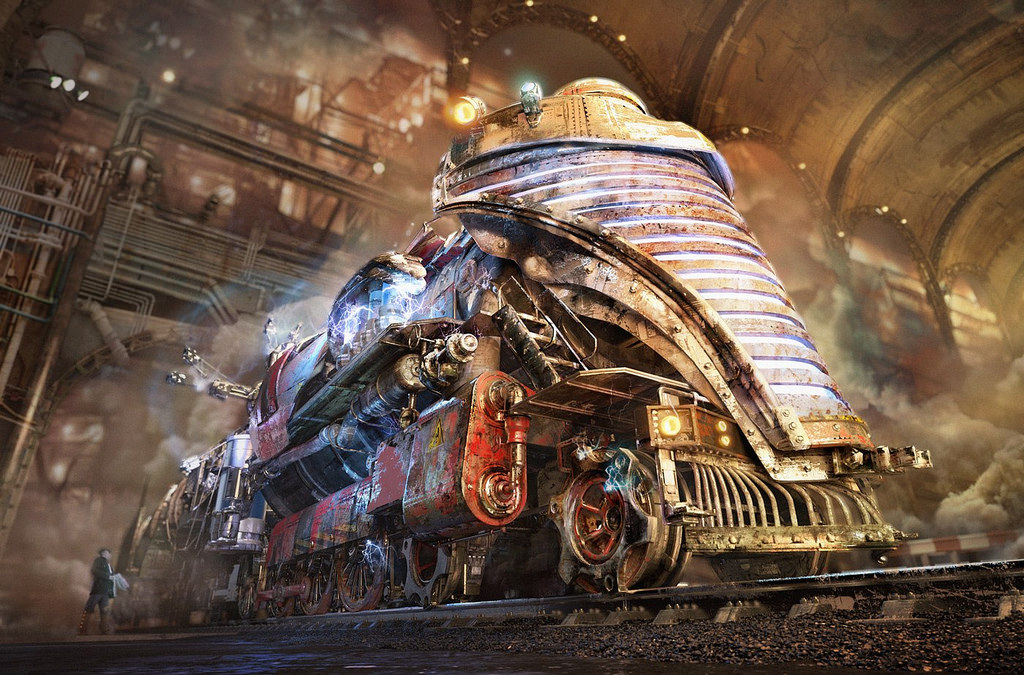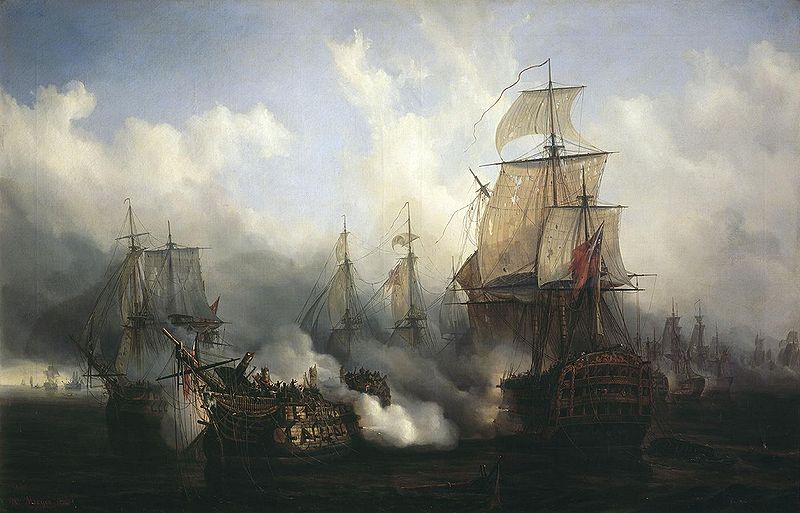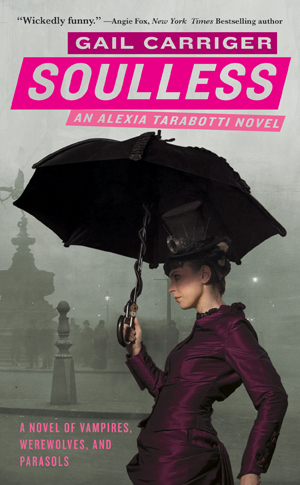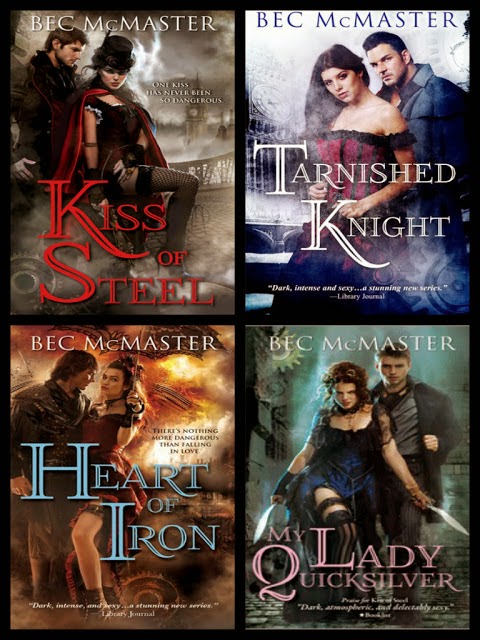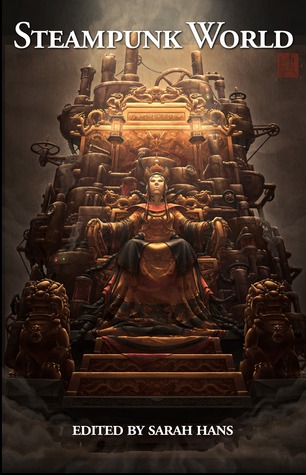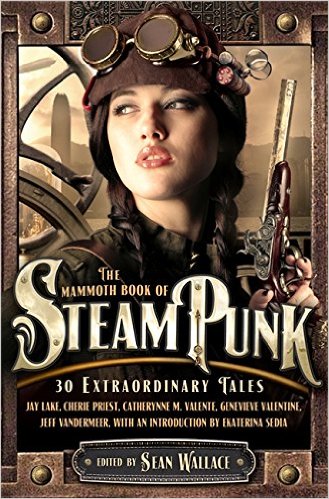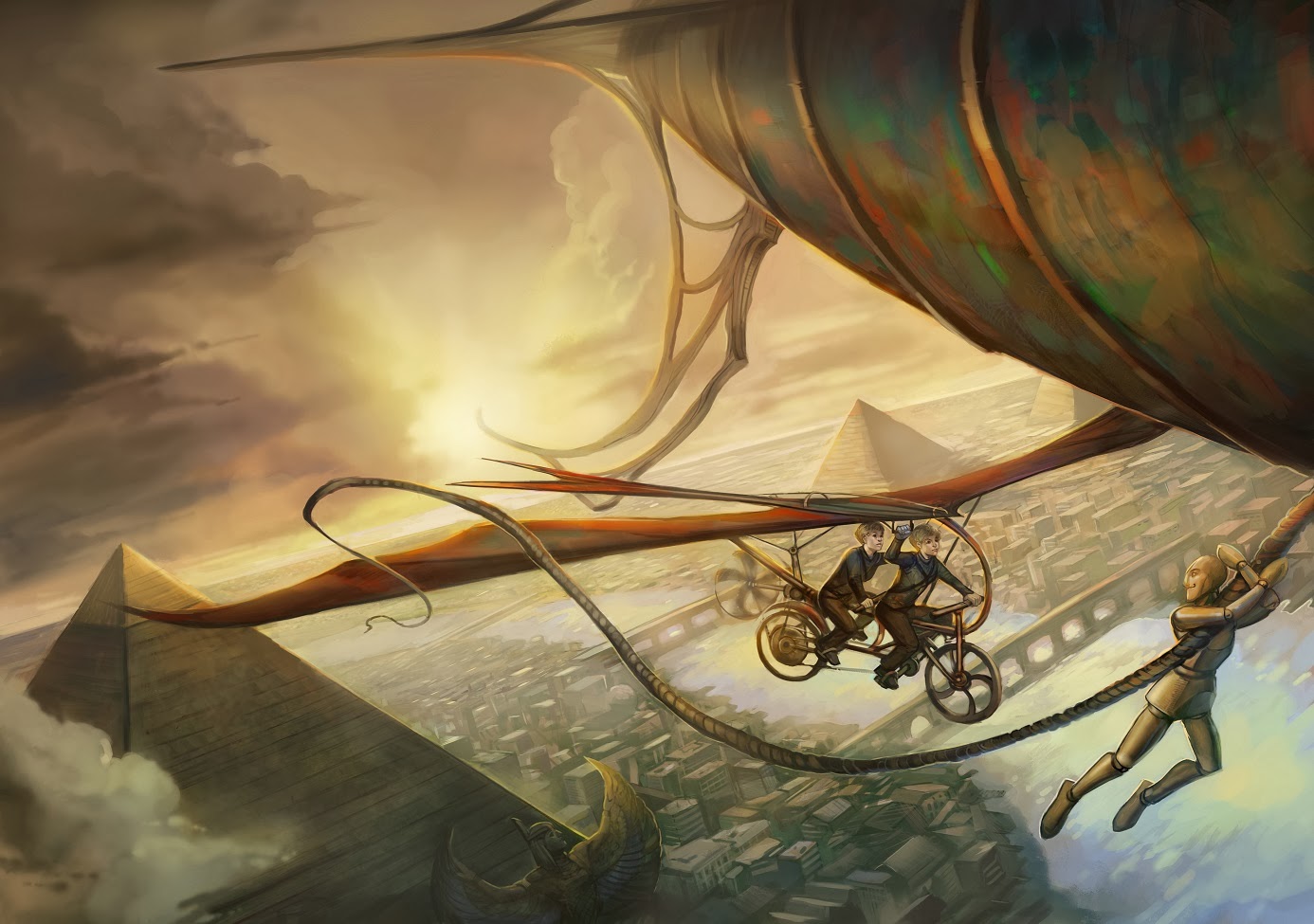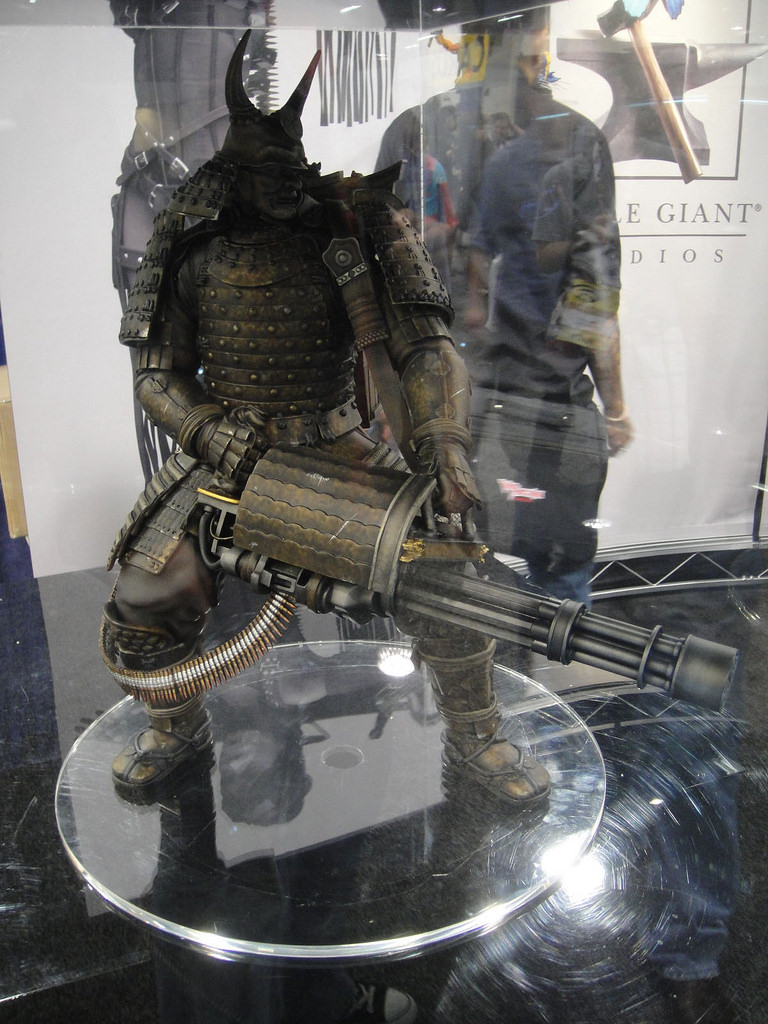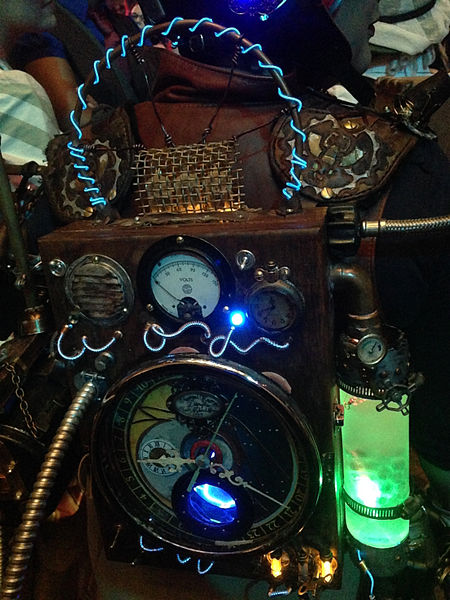AustLit
-
-
-
Some critics consider the real origins of steampunk to lie with the scientific romances of the nineteenth century, in the works of Jules Verne, H.G. Wells, and others of their ilk (see, Onion 140). These 'proto-steampunks' are seen to be writing in similar ways to their modern counterparts, speculating about advanced devices based on the technologies of the time, and how these might influence society on a broad level.
Howard V. Hendrix, for example, is forceful in his claim that
'although the steampunk subgenre generally presents itself as clubby British Victorian, steampunk is in fact a London gentleman's club founded by a French author, a British Victorian Phileas Fogg as puppeteered by a Frenchman, Jules Verne' (82).
For the most part, these authors were writing early speculative fiction, imagining through their work the potential effects of various advancements in technology. The Victorian fascination with science, the future, and the potential reorganisation of society afforded by such continues to be evident in many works of contemporary steampunk.
H.G. Wells’s invisible men and personality-freeing potions, Verne’s Nautilus, Mary Shelley’s ‘mad scientist’ and his galvanic creation of life—all these figures and more are seen to influence what would become steampunk.
In Australia, early works that explored the effects of anachronistically advanced technology included the likes of Banjo Paterson’s 'The Cast-iron Canvasser' (1891), in which a robot magazine canvasser is seen as more robust than his frequently abused human colleagues, Lancelot Lance’s futuristic fantasy Hortense (1906), which posits an advanced utopian society, or Kodak’s 'The Automatic Barmaid' (1917), in which a robotic barmaid proves to be no less inclined to listen to ‘blue’ stories than were her predecessors.
Even Joyce Vincent’s 'Yellow Peril' story The Celestial Hand (1903) partakes of elements that would come to be synonymous with steampunk, as a 'futuristically mechanised' Chinese army invades Australia, using chemical 'fume bombs', an 'air navy', 'blowers' that dissipate chemical weapons, the transmutation of metals, and mortars that can fire over a distance of five or six hundred miles.
-
The notion of 'proto-steampunk' is not, of course, without its critics: Lois Tilton, in a review of Ghosts by Gaslight for Locus Magazine in 2011, is firm in her refusal to shift the genre’s origins any earlier:
'Jules Verne did not write steampunk, he wrote scientific romance'.
But modern critics may no longer be able to hold that line: increasingly, nineteenth-century properties, from the Three Musketeers to Sherlock Holmes, are re-made and re-tooled with their retroactively assigned steampunk credentials front and centre. If such works were not proto-steampunk when they were written (which is undoubtedly the case) and were not considered proto-steampunk by first-wave steampunk writers (which is debatable), there is certainly a case that they have been firmly, if retroactively, been labelled proto-steampunk by twenty-first century readers – a temporal paradox that seems particularly fitting in a steampunk world.
-
Several different starting points are often touted as either the genesis of steampunk, or at least its solidification into a coherent form. We have discussed the nineteenth-century precursors to the style above, but here we are more concerned with how the style emerged in and of itself, as an identifiable genre that would become usable and recognisable by readers and authors alike.
The emergence of the style as word, as a set of features that might be named as such, was first in K.W. Jeter’s 1987 letter to Locus Magazine, and subsequently in William Gibson and Bruce Sterling’s The Difference Engine.
Jeter’s letter served to coin the word, as a tongue-in-cheek descriptor for the kinds of Victorian fantasies he was writing, and as a play on cyberpunk, a popular new genre at the time, whose prominent writers included Gibson and Sterling.
Following from this, Sterling and Gibson’s 1990 novel is, in Jess Nevins’ words, 'steampunk’s Ur-text' (516): the founding work that served as the basis for many of the tropes, themes, images, and ideas that would become the core elements of the style.
-
The novel is an alt.history re-imagining of nineteenth-century Britain that speculates as to what might have happened had Charles Babbage succeeded in initiating a computing revolution in Victorian England.
Social upheaval, radical class struggle, and reactionary politics are set amidst a hyper-industrial landscape of smokestacks, steam-power and vast clockwork machines.
In this we can see many of the main elements associated with steampunk begin to emerge: a Victorian-era setting (or a fascination with that time); advanced technology created using clockwork or steam-power; inventions and inventors; social struggle and upheaval. Given The Difference Engine as a model, we can come to a working definition of a kind of classic steampunk, the originary texts of the genre, and the works that continue to enact the original format and style with little to no addition or revision to these core elements.
Such works operate on alt.history principles, stressing the importance of intertextuality and bricolage, the gathering of real historical figures, events, and places in reimagined ways. This re-imagining is focused on technological jonbar hinges, wherein a particular innovation or advancement produces a futuristic past world whose social mores and aesthetics differ from our known past in a recognisable fashion while their technological and political issues remain resonant.
-
Airships, steam-powered computers, or clockwork cyborgs interact with the significant events and figures of the past, in so doing imagining different ways that our current world might have come about.
In this manner, The Difference Engine would come to prefigure not only the core features of steampunk but also many of its continuing political and thematic problems and issues, including concerns with imperialism, gender politics, freedom, technology, and class. In The Difference Engine, as in many works of steampunk continuing to the present day, these issues are not always handled in ways that are above criticism.
Steampunk’s engagement with the cultural, social, and aesthetic legacy of the Victorian era is a significant part of this. Many of the social and political ideas of the time are often reproduced (either unintentionally or through deliberate ventriloquism) by modern writers of the genre. For example, a fascination with empire, colonialism, and gender politics via women’s liberation often suffuses steampunk works.
-
While this frequently constitutes part of a critique of the politics of the time (and thus their ideological successors today), it also regularly serves to recapitulate and revel in the imperialism, sexism, and white supremacy implicit in such Victorian or pseudo-Victorian settings (Pho 35; Stimpson 21).
One should not, however, resort to sweeping generalisations of all steampunk that asserts a political bent in any particular direction.
While the steampunk style may contain common thematic or aesthetic veins that run through many key works, as the years have worn on, steampunk, as a field of fiction, art, culture and costume, has become ever more disparate and diverse.
Part of this diversification begins with the separation of the steampunk aesthetic from its punkish roots: a steampunk that consists mainly of an application of Victorian tropes and imagery to fantastic worlds with anachronistic technology. In this context, the political import of steampunk is left to the side often in favour of a more romantic bent, a steam-powered, cog-work aesthetic that is applied less critically to nineteenth-century history, technology, and sociality.
-
When did 'punk' become a less urgent component of 'steampunk'? As with its most nominative predecessor, cyberpunk, the tensions appeared when the previously niche subgenre began to expand and move beyond its original confines. As late as 2005, Nevins notes, definitions of steampunk varied little from K.W. Jeter's 1987 letter. By 2011, 'the term has become an intense semantic and philosophical battleground, albeit one whose combatants have little time for or interest in their opponents' (513).
This battleground is what Ben Peek (whose Red Sun Stories appear in this exhibition) terms 'The Great Steampunk Fight of '10'.
By 2010, steampunk was more visible and more accessible than it had ever been, even in the days of the Difference Engine.
-
Anthologies such as Nick Gevers' Extraordinary Engines and Ann and Jeff VanderMeer's Steampunk (both 2008) were introducing new steampunk authors such as Jay Lake (who had published Mainspring the year before) and reprinting them alongside work by first-wave steampunk authors such as James Blaylock. Scott Westerfeld had followed his Uglies series (which focused on the technologies of a future post-apocalyptic world) with Leviathan (2009), the first in a steampunk young-adult trilogy set on the cusp of World War I.
In Australia, The Mysterious Geographic Explorations of Jasper Morello (2004) was attracting awards and nominations across the world, Michael Pryor had begun his Laws of Magic series with Blaze of Glory (2006), D.M. Cornish's Monster Blood Tattoo series had debuted with Foundling (2006), and Richard Harland had published his first steampunk work, Worldshaker (2009).
Back in the United States, Cherie Priest had released Boneshaker (2009), an American gold-rush alt.-history with zombies, the first in her Clockwork Century series. And Gail Carriger had published Soulless (2009), the first volume of the Parasol Protectorate. The alt.-history world of the Parasol Protectorate was one of anachronistic technology (including telecommunications technology, the aethographor) that helped drive the plots, but it was also an urban-paranormal fantasy space of werewolves and vampires, lords and ladies, parasols and teas. Carriger's steampunk-infused paranormal romances were among the most popular, successful, and visible form of steampunk of the period: the Parasol Protectorate would run to four more books before the end of 2012, a young-adult spin-off series in 2013, and a second spin-off series in 2015.
Other international authors were also writing similar series, including Meljean Brook's Iron Seas (2010-2014), Pip Ballantine and Tee Morris's Ministry of Peculiar Occurrences (2011-present), and Dru Pagliassotti's Clockwork Heart (2008-2014.) In Australia, Jenny Schwartz began her Bustlepunk Chronicles (2011-2014), Annie Seaton her DeVargas Family Chronicles (2012-2013), and Bec McMaster her London Steampunk series (2012-2015).
-
The sumptuous and seductive world of Carriger and other authors of paranormal-romance-steampunk novels was popular, successful, and visible – and helped drive the increasingly urgent question, 'Is steampunk still "punk"?'
What Nevins calls a 'semantic and philosophical battleground' and Peek calls the 'Great Steampunk Fight of '10' was a response to the question of the 'punk' in 'steampunk': faced with an increase in works that threatened to make a full-blown genre from what had been a literary niche, writers and critics alike debated what made a work 'steampunk': was it the 'punk', or merely the steam, or could a work have neither and still be 'steampunk'?
Scottish writer Charlie Stross seems to have been the catalyst for the Great Steampunk Fight of '10, in a post called 'The Hard Edge of Empire' (27 October 2010). Stross argued not only that 'there's too damn much of it about right now', but that 'an affection for the ancien regime is an unconsidered aspect of the background of most steampunk fiction'.
The genre, he suggests, has fallen into a 'romanticization of totalitarianism' that ignores the brutal reality of the uneven socio-economic power structures that underpin nineteenth-century society:
'In other words, it's the story of all the people who are having adventures — as long as you remember that an adventure is a tale of unpleasant events happening to people a long, long way from home.'
American author Catherynne Valente followed Stross's post with her own analysis of the genre in 'Here I Stand, with Steam Coming Out of My Ears' (3 November 2010). Like Stross, Valente argued that steampunk was over-exposed and without the interrogative edge that made it 'punk':
'Of course, it's not a genre that cares about authenticity or emotion particularly, since it's all about the shiny veneer. All about the rewriting of the 19th century to be Tolkien's best fantasy of happy workers, inspired artisans, and noble aristos.'
-
In a direct response to Charles Stross, however, Scott Westerfeld countered that behind the veneer of cogs and inherited titles, steampunk authors remained conscious of their 'punk' roots, citing, among other sources, the postcolonial steampunk website Silver Goggles, run by Jaymee Goh, and Nisi Shawl's 'Stupid Things We Say', itself an outgrowth of a convention panel on 'The Politics of Steampunk' at WisCon 34 (May 2010).
People critiquing modern steampunk for being superficial, Westerfeld suggests, are themselves only looking at the genre superficially.
Critical works, too, showcased the difficulty of theorising the increasing space of steampunk. In 2010, the journal Neo-Victorian Studies devoted issue 3.1 to 'Steampunk, Science, and (Neo)Victorian Technologies'. The theoretical tensions at play are evident from the opening sections of Rachel Bowser and Brian Croxall's introduction: first noting that 'one common element arguably shared by all steampunk texts, objects, or performances is the [...] invocation of Victorianism' (1), they contradict this position within two pages, noting that 'Steampunk does not, however, consistently set itself or its stories in the past – or even consistently in a future that looks like the past – but overtly blends various time periods' (3).
While the desire to tie steampunk to the journal's own neo-Victorian focus necessitates an emphasis on the Victoriana of classic steampunk, the various analyses are also unwittingly destabilised by the fact that the genre under examination is shifting, expanding, and morphing even as it is being defined. This generic slipperiness influences each article in the issue. Patrick Jagoda, for example, positions his article as a way of grappling 'with the historical, scientific, and aesthetic complexity of steampunk' (47), but focuses exclusively on Bruce Sterling and William Gibson's The Difference Engine, a work that was then twenty years old.
Mike Perschon argues that
'The difficulty in defining steampunk stems from the evolution of the term as a literary sub-genre of science fiction to a sub-culture of Goth fashion, Do-It-Yourself (DIY) arts and crafts movements, and more recently, ideological counter-culture' (127-128),
an ideological stance that serves to both freeze steampunk writing as a literary curiosity and decentralise the role of writing in the definition of the form. And Jason B. Jones contracts steampunk to a 'fascination with brassy, overstuffed Victoriana' (99), even as he simultaneously acknowledges that 'Steampunk motifs also show up often in comics [...] even when the world is not especially Victorian' (99).
One of the earliest sustained critical engagements with steampunk, Neo-Victorian Studies, perhaps unwittingly, demonstrates the same concerns that were arising among authors: the difficulty of definition and the simultaneous desire to find a definition, a marginalisation of the writing in favour of the more dramatic aesthetic aspects of the movement, and a focus on canonical texts that worked to diminish and obscure the writing on the margins of the genre.
Much like the genre itself, however, critical responses to steampunk were, and remain, complex and varied.
Brigid Cherry and Maria Mellins, in the inaugural issue of Punk & Post-Punk, argue for the 'punkness' of steampunk, but their argument notably rests on steampunk as a cultural activity, rather than as a literary form: for Cherry and Mellins, the 'punk' lies in the practitioners' 'display of difference' (5) in moving anachronistically through the real, modern world. For them, it is not the genre that is 'punk':
'the term steampunk did not originally encapsulate a deliberate punk aesthetic, and was never intended to by its originating authors' (6).
-
Furthermore, they argue, early steampunk communities 'resembled a fan culture rather than a youth subculture (6), and were by definition not 'punk' until the cultural activity accelerated past the fiction as the primary output of 'steampunk'.
Conversely, Ekaterina Sedia argues in her introduction to The Mammoth Book of Steampunk on behalf of the fiction itself:
'this examining and interrogation of the past, the search for alternative turns, imagining what would happen if technology were used to uplift rather than oppress: this is the "punk" element, the rejection of calcified norms and either examining them or appropriating them for the use these norms had previously shunned'.
Writing from the margins, too, began to place a particular emphasis on ‘punk’, where the establishment was colonial legacy, Eurocentricism, heteronormativity, Christianity. From post-colonial South-East Asian steampunk and African-American steamfunk, to dirigible-infused lesbian romances, to the proposed 'Shariah Steampunk' of UK-based Yakoub Islam—the more the genre grew and seemed to stabilise as a mainstream form, the more room there was for punk.
-
As steampunk has moved into wider recognition by readers of speculative fiction and the general public alike, the circle of texts included by the tag has expanded and diversified.
Many of the original elements associated with steampunk, such as an alt.history focus and technological-political bent, have become less essential to what is understood as steampunk.
-
Now existing as a recognisable style in itself, steampunk has become more open to experimentation and reinvention. Elements from other forms of speculative fiction have been borrowed and incorporated into steampunk works. Magical steampunk includes those works that engage with many of the typical tropes and features of steampunk, but with the addition of a magical element. This can come about as an addition to the real-world historical worlds of traditional steampunk, or a core feature of secondary worlds.
The emergence of secondary-world texts in the style has produced works that include traditional steampunk technologies and tropes, but operate entirely in a fictional universe, rather than in our recognisable historical-fiction framework.
Such secondary worlds are often pseudo-Victorian in flavour, or remain influenced by real-world historical events, figures, and culture, but nevertheless they differ strongly from the real world.
Further offshoots have sprung up, riffing on the technological-historical themes of steampunk. These include dieselpunk, which focuses on anachronistic or post-apocalyptic petro-chemical technologies, or silkpunk, which uses the steampunk principles of historical fiction and anachronism, only supplanting steam with bamboo in an eastern setting.
In a similar vein to silkpunk, there are steampunk stories that drop the western-Victorian element, instead focusing on other historical cultures or alternate worlds inspired by non-Victorian culture, suffused with steam-powered and clockwork technology. These works are often written with a post-colonial bent, seeking to establish the potential for the genre for those who exist outside of hegemonic western subjectivity.
Steampunk elements are also added to many works which otherwise have little to do with the original purview of the style, constituting a kind of vague-steampunk field. That is, an application of selected steampunk tropes to other works in relatively minor ways, such that the work would often be better categorised as a kind of steampunk-esque version of something else, rather than a solely steampunk text. While more prescriptive definitions of steampunk would categorise these works as not truly being part of the style (Tilton 1), these are works that are either written by their authors or understood by readers (or both) as being situated within the discursive field of steampunk fiction, engaging (at least to an extent) with the tropes, images, and themes of steampunk.
-
Such a liberal use of steampunk elements across different genres and settings indicates that the general understanding of steampunk has reached a stage where it can be diluted almost to non-existence and remain recognisable.
It now exists in the public imagination as an aesthetic, an iconography, and a general praxis of reimagining the past through technology.
This is in no small part due to the popularity of steampunk outside of fiction: a make-it-yourself costume, craft, and culture that exists, if not independent of the fiction, then at least in a manner that is not wholly reliant on it.
Though the steampunk movement of craft and costume emerged following the fiction, it now has enough traction in and of itself to reflect its influence back upon its originator. It is a community of artists, tinkerers, makers and costumers who create, use, and wear items that reflect a steampunk aesthetic and ethos. Everyday technological items, from the complex to the mundane, are decorated and redesigned with the principles, materials, and materiality of the Victorian era. Brass, copper, ornate latticework, or lacy frills are the hallmark tropes of steampunk iconography.
-
Steampunk craft foregrounds an interest in the physicality of the mechanical, as opposed to the glossy digital abstraction of much contemporary technology.
The machine is humanised and integrated with the world through the exposure of cogs and gears, the unobscured sound of mechanical clacking and winding (Onion 145-146). Steampunkers also show a fascination with a time before mass production – a fondness for items that lack the ubiquity of generalised blandness, instead bearing stamps and signatures unique to their users. Modifications, re-used materials, or self-made versions of the intricate carvings and scrollwork associated with Victorian sensibilities serve to individualise objects, and craft them in their maker’s own image.
The popularity gained by this subculture has multiple underlying reasons, and not all practitioners share the programmatic intentions of others. Indeed, even when the surface-level reasons may appear identical, there can be vastly different belief systems at work underneath (Ferguson 66). There are, however, veins of theory and intent that run through much of the subculture, underlying the success of steampunk craft both as a countercultural movement and aesthetic hobby. To lesser or greater extent, many of these ideas and intentions have to do with the ‘punk’ of steampunk.
For example, the ethos of do-it-yourself practicality and the tinkerer’s modification often function as a form of resistance to mass-produced corporate control over the materiality of everyday life. The steampunker’s reassertion of control over the aesthetics and design of their material life is a (relatively minor, but important) pushback, symptomatic of an ethos of self-sufficiency, self-making, and individual freedom. Yet this very program of self-empowered liberation is itself fraught, full of potential pitfalls for the unwary or uncritical.
In SteamPunk Magazine, the steampunker’s mission is given as no less than:
'rebuilding yesterday to ensure our tomorrow… we are archaeologists of the present, reanimating a hallucinatory history' (cited in Pho 36).
-
This statement, manifesto-like, demonstrates an awareness of the potential of, and the difficulties facing, a movement that seeks to revive the sensibilities of the past. As to its potential, the toolbox of the Victorian imaginary can be repurposed to critique present institutions, the nineteenth century acting, in Paul di Filippo’s words, as 'the roots of our current global scene' (Yaszek 190). A steampunk archaeological history approaches the past so as to understand its current influence, recuperate those favourable elements, and draw attention to its failings. Yet this process is not always so critical, and can often fall into the trap of becoming that which it mimics (Stimpson 22).
As with the fiction, steampunk runs the risk of ventriloquising Victoriana’s flawed ethics and acts.
The character of the heroic explorer may mask the damage wrought by imperial expansion, while the innovative industrialist might romanticise the horrific labour conditions that underwrote the Victorian economy. Indeed, it has been argued by some steampunkers, such as Diana Pho, who runs the website Beyond Victoriana, that the resistance of self-making, modification, tinkering, and decoration is the resistance of the wealthy. It requires time, money, and materials that are only available to those at the receiving ends of globalised production (35-36).
The freedom for self-making, individuality, and self-expression is a freedom which, in many cases, is not intersectional. In all these cases, the danger is always that an aesthetic of empire will lapse into a reproduction of the imperial ideology (Stimpson 21). Despite these ongoing debates and difficulties within the subculture, it remains a thriving and energetic network of communities whose creations both draw on, and influence in return, the continuing fictional discourses of the style.
You might be interested in...


